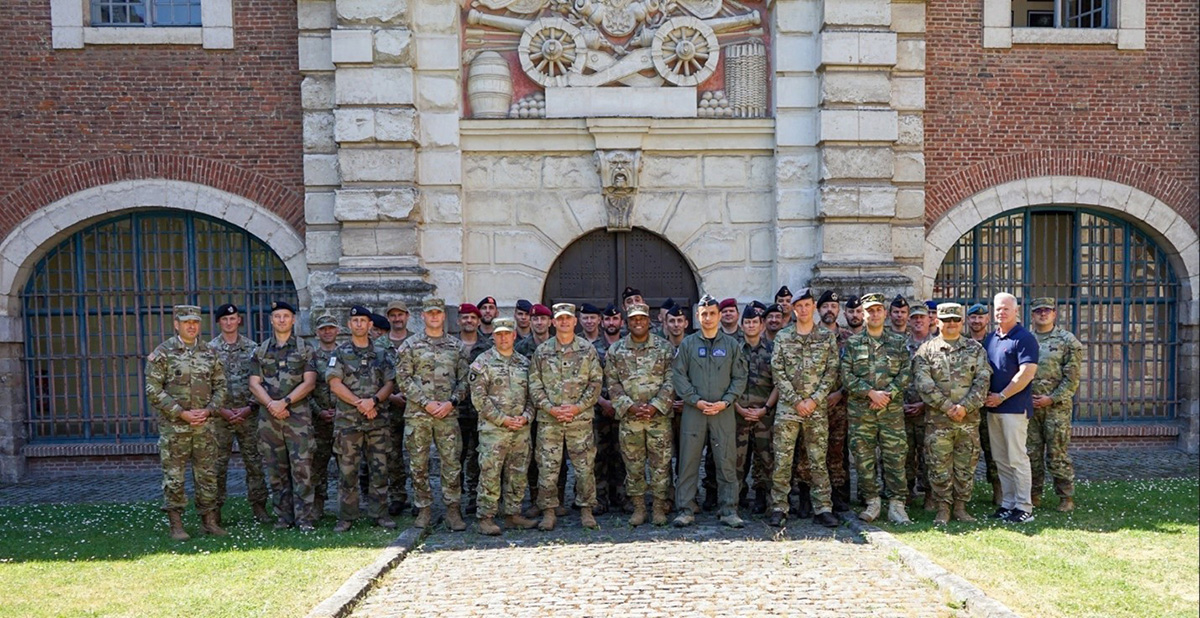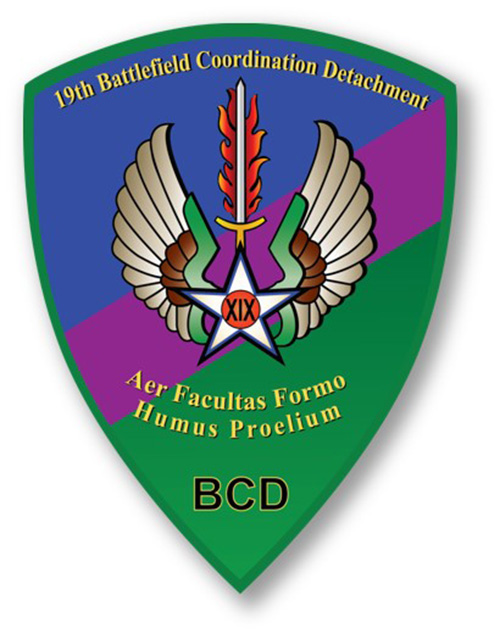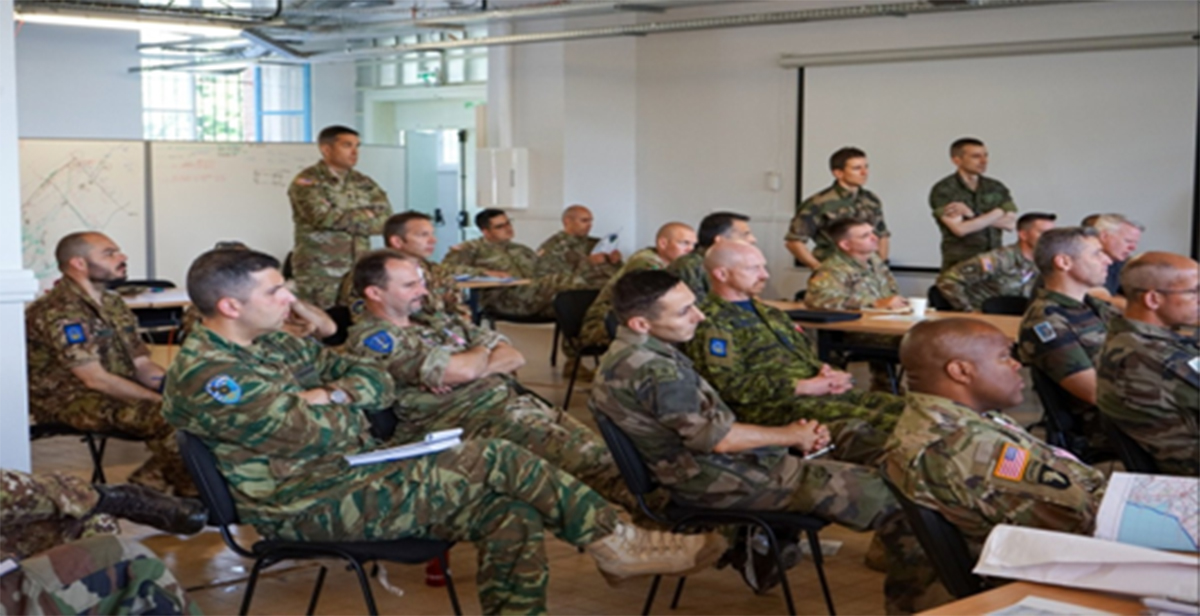The Battlefield Coordination Detachment in Future Warfare
By COL Kevin L. Jackson
Article published on: December 12, 2024 in Field Artillery 2024 E-edition
Read Time: < 7 mins

19th BCD and the Army Joint Suppor Team conducting an Air Land Integration Symposium with Rapid Reaction Corps France in Lille, France.
Future warfare will necessitate service interdependence, and the theater air control system (TACS) will remain key to effective joint force integration and mission success. The TACS includes critical liaison elements from each component: the Army's battlefield coordination detachment (BCD), the Air Force's joint air component coordination element (JACCE), the naval and amphibious liaison element (NALE), the Marine amphibious liaison element (MARLE) and the special operations liaison element (SOLE). Each element within the TACS can build capacity, interoperability and synchronization across the components from the tactical level through the operational and strategic levels of warfare.

The services must continue to man, train and equip these formations with the most qualified personnel to act on behalf of the component commander or designated joint task force commander. Monitoring the war in Ukraine has demonstrated how each element of the TACS assists in crisis management and builds situational awareness during conflict for our component commanders. The ability to leverage joint force capabilities against any problem set and focus on the joint force commander's priorities, no matter who the supported commander is, remains the key to future success. In this article, we will examine how the Army's BCD helps build warfighting capacity and improve operational synchronization, which is essential to achieving convergence against a near peer threat.
The BCD is a multi-functional Army organization that enables select operational functions as the senior liaison between the Army Forces (ARFOR) commander and the air component commander. BCDs are aligned within geographic combatant commander's air operation center (AOC) around the world. The BCD interfaces with the appropriate staff directorates within the AOC to ensure that the Army commander's requirements are represented to the air component commander (ACC). An AOC is inherently a joint or multinational organization. Key tasks for the BCD include exchanging current intelligence and operational data (priorities, friendly order of battle and scheme of maneuver) and support requirements (intelligence, surveillance and reconnaissance, joint fires, space effects, suppression of enemy air defense and electronic warfare) as well as coordinating ARFOR requirements for airspace coordination measures (ACM), fire support coordination measures (FSCM) and theater airlift.1
The BCD doctrinally does not interact with the corps unless the corps is designated as a joint task force or serves as the land component commander. In the last year, 19th BCD in Europe has learned that the BCD can significantly impact the land component's objectives while in competition by nesting efforts across the breadth of the land component to include corps and their assigned divisions. This nesting allows the BCD to better understand and integrate land component efforts at echelon and strengthen theater effects. The BCD's presence in the AOC provides access to multiple joint components and multinational partners and allows the BCD to pass information and opportunities to the corps and vice-versa. The 19th BCD and command relationship with the theater fires command (56th Artillery Command) strengthens the targeting kill chain and allows synchronization across all domains with the multi-domain task force and other assets available to the theater fires command. A renewed relationship with corps headquarters (HQ) and enablement by the theater fires command provides unlimited opportunities for future warfare with the BCD. It is worth noting that while this expansion beyond the doctrinal mission of the BCD works in competition and builds the foundation for success in crisis and conflict, the BCD must return to its doctrinal mission of liaising between the land and air components in crisis and conflict to be effective.
As a second example, the 19th BCD is leveraging air mobility as a weapon system. The BCD works closely with airborne units, and the BCD's unique relationship with the air component's tactical airlift squadron improves the efficiency and support to Army formations. The BCD in competition plays a critical role in hosting the European Joint Airborne Air Transportability Training conference for the theater to ensure proper allocation of air support to land component airborne units. As a result, the Army can continue building competency during competition that could enable a joint forceable entry operation in conflict. The corps also have High Mobility Artillery Rocket System (HIMARS), and the relationship of the BCD and assigned corps' Fires brigade allows increased support to conduct HIMARS rapid infiltration (HIRAIN) training. Additionally, it increases the air component's familiarity with employing an Army key weapon system and its associated critical munitions like Army Tactical Missile System (ATACMS) to support the component commander's operational requirements. The 19th BCD provides the core of the North Atlantic Treaty Organization (NATO) Allied Land Command (LANDCOM) BCD in competition and can level multinational assets like the Belgian A400 and Hungarian C-17s for joint forceable entry operations.
Advancing technology of both friendly and enemy capabilities is changing the supported versus supporting roles by phase. For example, Ukraine has shown how contested airspace may limit maneuver and the need to destroy the integrated air defense systems (IADS) is essential. The need to destroy IADS in the initial phases of a conflict may require the air component to be the supported command. The land component's current long-range and mid-range munitions like the Guided Multiple Launch Rocket Systems (GMLRS), ATACMS and other future munitions capabilities—like the Precision Strike Missile (PrSM) and hypersonics—may be used to support the air component in destroying IADS assets. The air component's ability to quickly reposition materiel, munitions and equipment—specifically HIMARS—might be critical for the initial phases of a conflict. The need to train this capability and establish coordination and employment techniques are paramount for future warfare and the ground liaison officer can be a tremendous asset with these efforts.
The BCDs all have associated ground liaison detachments (GLD) or a reconnaissance liaison detachment (RLD). The GLDs are manned with a senior Field Artillery captain and a senior fire support non-commissioned officer (NCO) while the RLDs are manned with a senior Intelligence captain and a fire support NCO. The role of the GLD and RLD are a lesser-known capability of the BCD and are often underutilized in helping achieve the land component commander's objectives. I would argue that they are a critical component to integrating joint capabilities into the land component's scheme of maneuver. The GLDs can integrate key capabilities for the land component to include F35s, F16s and other sensors with link technology that enable long-range fires.

19th BCD and the Army Joint Support Team conducting an air-space practical exercise with Rapid Reaction Corps France and Eurocorps in Lille, France.
The RLD's ability to integrate with the air component's intelligence, surveillance and reconnaissance (ISR)group or distributed ground station enterprise is vital to the Army. The RLD can work to dynamically re-task intelligence assets or get Air Force support in advanced target development for key targeted areas of interest that will enable Army success in the future. The “best athlete” from each component is what matters to enhance and achieve effects for the joint force commander. GLDs and RLDs are vital to achieving that effect.
The BCD is trained, manned and equipped to coordinate for the land component to the air component across all domains with a few additional resources. The synergy of the BCD within the AOC and access to other liaisons from other components residing in the AOC enhances coordination across all domains. For example, the NALE's presence in the AOC allows coordination for bomber task force missions, protection and other maritime capabilities potentially provided for the land component. Some BCDs have Space officers who coordinate Space operations with the theater fires command, multi-domain task force and the Space Force. A few additional personnel with functional expertise in space, cyber and electronic warfare added to the BCDs' modified tables of organization and equipment (MTOEs) would allow coordination for the Army's joint capabilities across components and capabilities from other components leveraged in support of Army and land component operations.
The BCD, though small, has senior officers and NCOs in key positions with subject matter expertise in key warfighting capabilities which include targeting, airspace management and intelligence. The BCD can assist the air or land component commander in helping to build capacity with other multinational formations. For instance, in a security force assistance or teach, coach, mentor role, the BCD could send functional experts to provide tailored training packages to improve the readiness of multinational component organizations. The BCD could also identify gaps in doctrine and assist both national and multinational partners and allies in developing effective tactics, techniques and procedures (TTPs) that increase their overall warfighting capability.
In the European theater of operations, the BCD has taken advantage of several opportunities to increase warfighting capability across NATO at the tactical, operational and strategic levels of warfare. Below is a short summary of efforts with NATO that build flexibility and capability for the joint force. At the tactical level, the BCD in Europe utilizes training and engagement at NATO corps HQs focused on air-land integration to increase warfighting capability, as well as provide the land component increased synchronization with NATO units across Europe. At the operational level, the BCD utilizes engagements with NATO LANDCOM and Allied Air Command (AIRCOM) to share U.S. Army doctrine, systems, processes, TTPs and lessons learned as a roadmap for success in the air-land integration arena. The use of programmed battle staff training events with both AIRCOM and LANDCOM—focusing on targeting, the joint air tasking cycle and unit air space management— has been key to success prior to major joint exercises.
The future fight is both joint and multinational with increased reliance on technology across all domains. The elements of the TACS structure, like the BCD for the land component, are key to leveraging the “best athlete” resident in each component to impact the fight for the joint force commander. BCDs will continue to execute those tasks at the component level while the GLDs and RLDs remain as the critical linkage at the tactical level for employment and coordination of joint assets. Commanders that enable flat organizations that nest operations and efforts from tactical to strategic level encourage disciplined initiative and convergence of effects across the joint force.
Author
COL Kevin L. Jackson is a career Army field artillery officer and has held a variety of operational and broadening assignments. His operational assignments include Brigade Commander 19th Battlefield Coordination Detachment, Battalion Commander 2-15th Field Artillery Regiment, Battalion Operations and Executive Officer 1-377th Field Artillery and Brigade Operations Officer 17th Fires Brigade. His broadening assignments include Field Artillery LTC assignment officer, HRC strategic initiatives officer, Joint Staff J35 and Office of the Secretary of Defense Policy. He is currently serving as the Chief of Staff for V Corps at Fort Knox, KY.